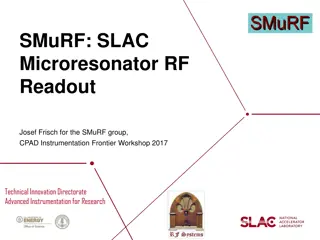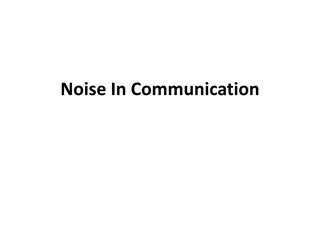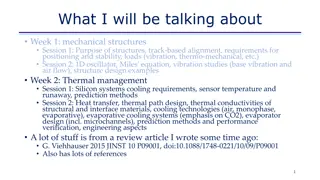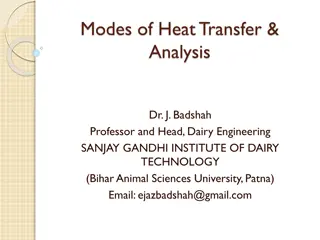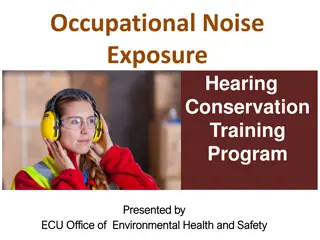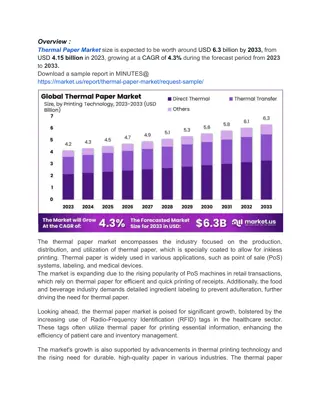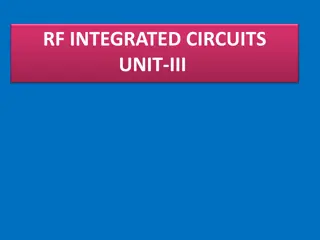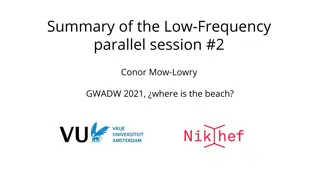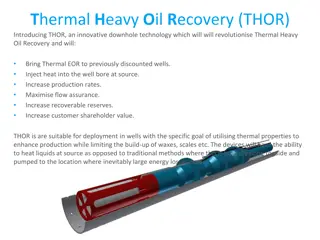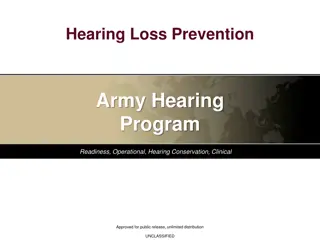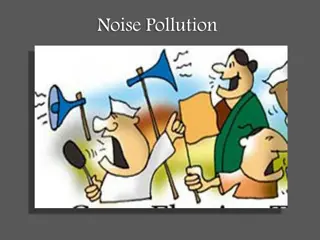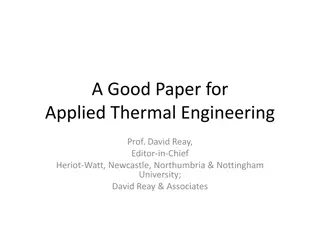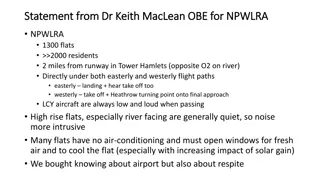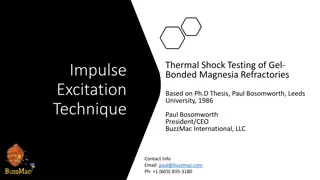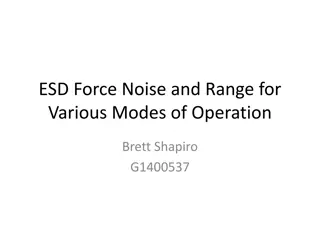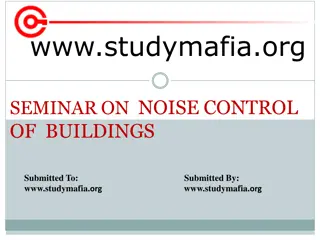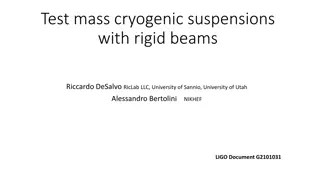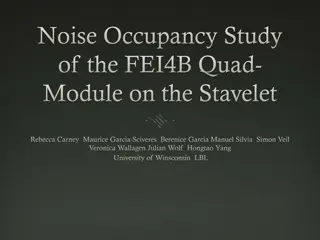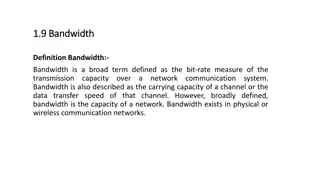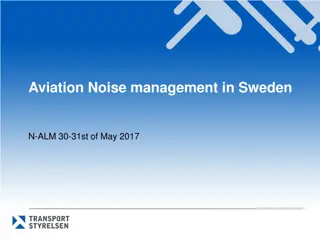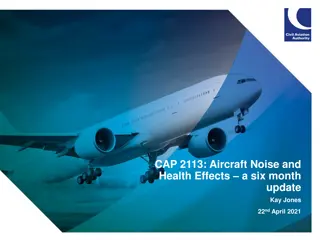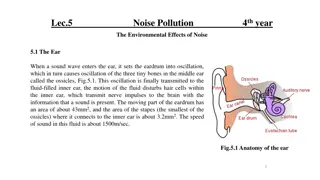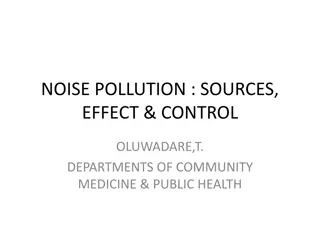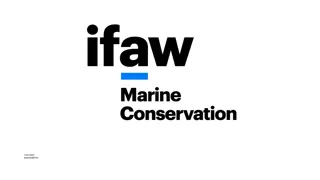Understanding Frequency Weighting in Noise Pollution Measurement
Frequency weighting is essential in noise pollution measurement to reflect how the human ear perceives noise. The A, C, and Z weightings are commonly used to represent different frequency responses. A-weighting covers the audible frequencies where the human ear is most sensitive, while C-weighting i
2 views • 7 slides
SMuRF: SLAC Microresonator RF Readout
SMuRF group at SLAC developed a cutting-edge RF readout system for cryogenic micro-resonators used in research. The system features cold resonators tuned with TES current and a flux ramp to eliminate 1/f noise. Key technical challenges include noise, linearity, wide bandwidth, and computation power.
3 views • 16 slides
Implementation of Utility Thermal Energy Network (UTEN) and Jobs Act Update
The implementation of the Utility Thermal Energy Network (UTEN) and Jobs Act involves a series of events and discussions, including the signing into law, technical conferences, pilot project proposals, and withdrawals. Various utilities have proposed pilot projects targeting different types of custo
3 views • 15 slides
Understanding Noise in Communication Systems
Noise in communication refers to unwanted energy that interferes with signal reception and transmission. It can be categorized as external or internal noise, each with various subtypes like atmospheric noise and shot noise. Recognizing and managing different types of noise is essential for ensuring
1 views • 8 slides
Thermal Management and Mechanical Structures Overview
This content provides detailed information on mechanical structures and thermal management in engineering systems. Topics include the purpose of structures, alignment, stability requirements, thermal loads, vibration studies, heat transfer, cooling technologies, and the importance of effective therm
1 views • 37 slides
Understanding Thermal Energy: Transfer & Transformation
Explore thermal energy and its transfer mechanisms such as conduction, convection, and radiation. Learn how thermal energy moves between objects of different temperatures, and why heat is always transferred, not coldness. Enhance your knowledge on the fascinating world of thermal energy dynamics.
0 views • 14 slides
Understanding Heat Transfer: Conduction, Thermal Conductivity, and More
Explore the fundamentals of heat transfer through conduction and thermal conductivity as explained by Dr. J. Badshah. Learn about the modes of heat transfer, Fourier's law, thermal resistance, and the relationship between thermal and electrical conductivity. Discover the essential features of therma
0 views • 9 slides
Understanding Thermal Conductors and Insulators in Energy Transfer
Today's lesson focuses on energy transfer, specifically on conductors and insulators. Learn about the characteristics of thermal conductors and insulators, how they affect the flow of thermal energy, and their real-life applications. By the end of this lesson, you will be able to distinguish between
0 views • 13 slides
Understanding Thermal Power Plants: Overview and Operation
Thermal power plants play a crucial role in converting heat energy into electricity for various applications. This article covers the definition, layout, working principle, and components of thermal power plants, highlighting their advantages and top features. From converting heat into mechanical po
0 views • 20 slides
Occupational Noise Exposure and Hearing Conservation Training Program
Learn about the Occupational Noise Exposure and Hearing Conservation Training Program presented by the Office of Environmental Health and Safety at ECU. This program aims to educate workers about the risks of noise-induced hearing loss, the importance of prevention, and the selection of appropriate
1 views • 20 slides
Understanding Thermal Properties of Materials
Materials respond differently to heat based on their thermal properties such as heat capacity, thermal expansion, conductivity, and shock resistance. The ability of materials to absorb heat, expand with temperature changes, and conduct heat varies across ceramics, metals, and polymers. Heat capacity
0 views • 19 slides
Understanding Solar Thermal Technology Basics
This content covers the basics of solar thermal technology, including insolation, passive solar design, and active solar systems for producing hot water. It explains the uses of solar thermal energy in domestic, commercial, and pool heating applications. The efficiency of solar thermal panels compar
1 views • 13 slides
Understanding Bacterial Spore Survival and Thermal Death Rates
Survival of bacterial spores during heat processing is crucial for food safety. The concept of Decimal Reduction Time (D value) and Thermal Death Time (TDT) curve help in understanding the thermal destruction of bacteria or spores. The Z value indicates the change in temperature necessary to cause a
6 views • 14 slides
Thermal Properties of Frozen Foods: Importance and Modeling Equations
Understanding the thermal properties of frozen foods is crucial for ensuring food safety and quality. Dr. J. Badshah discusses the significance of freezing, reduction of microorganism activity, and the role of thermal properties like density, specific heat, and thermal conductivity. Freezing point d
0 views • 15 slides
Healthcare Sector's Growing Adoption of RFID Tags Boosts Thermal Paper Market
Thermal Paper Market By Printing Technology (Direct Thermal, Thermal Transfer, Others), By Width (2.25\u201d (57mm) and 3.125\u201d (80mm)), By Application (Lottery & Gaming, Point of Sale (PoS), and Tags & Labels), By Region and Companies - Industry
0 views • 4 slides
Understanding Noise in RF Integrated Circuits: Thermal and 1/f Noise
Noise, an unwanted input, limits a system's ability to process weak signals. Sources of noise include random noise in resistors and transistors, mixer noise, undesired cross-coupling noise, and power supply noise. Thermal noise, caused by thermal agitation of charge carriers, is also known as Johnso
1 views • 49 slides
Insights from ET-ISB Workshop on Low-Frequency Noise and GWADW 2021
The ET Instrument Science Board held a workshop focusing on addressing key challenges related to low-frequency noise in gravitational wave detectors. Experts discussed topics such as mirror temperature, dealing with low-frequency noise realities, and facility limits. The workshop highlighted the sig
0 views • 13 slides
Advanced Understanding of Low-Frequency Noise in Instrumentation
Understanding low-frequency noise in instrumentation has advanced significantly, emphasizing the need for an integrated approach to predict and mitigate such noise. Recent studies show that low-frequency noise in third-generation instruments is exceptionally better than in second-generation detector
0 views • 11 slides
How to Create Thermal Images from a Thermal Flashlight
Thermal flashlight images can be made using different approaches such as long exposure photography or using light tracking software. This guide provides detailed steps on how to capture thermal images effectively with tips on light tracking apps, long exposure techniques, and imaging locations for o
0 views • 8 slides
Understanding Noise in Communication Systems
Noise in communication systems refers to unwanted signals that interfere with desired signals, originating from various sources such as interference from human-made sources and naturally occurring random noise. This noise can arise from factors like cross talk, power supplies, ignition systems, and
0 views • 19 slides
Revolutionary Downhole Technology for Thermal Heavy Oil Recovery (THOR)
THOR is an innovative downhole technology that aims to revolutionize Thermal Heavy Oil Recovery by bringing Thermal EOR to previously discounted wells, increasing production rates, maximizing flow assurance, and enhancing recoverable reserves. THOR's key benefits include flexible power options, safe
1 views • 6 slides
Understanding Receivers and Noise in Radio Astronomy
Discover the challenges faced in radio astronomy due to noise, with the signal often indistinguishable from background noise. Learn about receiver sensitivity issues, minimizing thermal noise, and mitigating atmospheric effects to improve observation quality. Explore the essential elements of telesc
0 views • 55 slides
Protect Your Hearing: Strategies for Prevention
Strategies for minimizing noise-related threats in operational environments are crucial to prevent permanent hearing loss. Understanding the risks of loud noise exposure, utilizing hearing protection, undergoing regular audiometric testing, and maintaining noise records are essential components of t
0 views • 22 slides
Understanding Noise Pollution: Sources, Terminology, and Measurement
Noise pollution is defined as undesirable sounds that disrupt human and animal life. This article explores the sources of noise pollution, terminology used in its measurement, and its impact on urban environments. Major sources include traffic noise, industrial machinery, and household activities. U
1 views • 26 slides
Understanding Noise Control Methods in Environmental Engineering
Explore the concepts of noise control in environmental engineering, focusing on mufflers, reactive mufflers, and noise control in the transmission path. Learn about absorptive and reactive mufflers, their principles, and applications. Discover how barriers and panels can effectively reduce noise tra
0 views • 9 slides
Insights into the Editorial Process of Applied Thermal Engineering Journal
Applied Thermal Engineering journal, under the leadership of Editor-in-Chief Prof. David Reay, has a rich history dating back to 1981. The journal's evolution, from its origins as Heat Recovery Systems to its current name and scope, reflects its commitment to advancing thermal engineering knowledge.
0 views • 29 slides
Optimizing Riparian Buffers for Thermal Protection in Teanaway River Watershed
Explore the study comparing optimized riparian buffer designs with fixed-width buffers in non-fish bearing streams of the Teanaway River watershed, focusing on maximizing thermal energy reductions with considerations for channel orientation and forest density. By utilizing NetMaps and thermal energy
0 views • 24 slides
Concerns Regarding Airplane Noise Impact on Residents in Tower Hamlets
Dr. Keith MacLean OBE provides a statement on the impact of airplane noise on over 2000 residents living in 1300 flats within a 2-mile radius of a London airport in Tower Hamlets. The residents face challenges with noise disturbance from easterly and westerly flight paths, with proximity to both lan
0 views • 10 slides
Thermal Shock Testing of Gel-Bonded Magnesia Refractories
Study conducted by Paul Bosomworth at Leeds University in 1986 aimed to reduce mechanical damage after thermal shock in magnesia refractories used in sliding gates. The research focused on using gel-binders and achieving optimum grain packing to enhance thermal stress damage resistance. The study al
0 views • 7 slides
Understanding ESD Force, Noise, and Range in Various Modes
This content discusses ESD force, noise, and range in different modes of operation, presenting assumptions, possible operation modes, and details on maximum range mode and noise characteristics. It explores concepts like control voltage offset, force noise calculations, and practical applications fo
0 views • 9 slides
Noise Control Measures and Community Preferences at the Corn Exchange
Various images and references discuss the history of amplified music events at the Corn Exchange, noise complaints leading to control methods by the FTC, impacts on events and community preferences post-control, and survey findings on participant demographics, noise effects, and desired public event
0 views • 19 slides
Noise Control Strategies for Buildings: A Comprehensive Seminar Overview
Explore the impact of noise on health, methods to control noise in buildings, and various techniques including room acoustics, wall and floor construction, space planning, HVAC soundproofing, and more. Understand the importance of noise reduction for overall well-being and effective sound management
0 views • 20 slides
Innovative Solutions for Cryogenic Suspensions Using Compressive Flexure Beams
Test mass cryogenic suspensions with rigid beams pose conflicting requirements, such as thermal noise reduction and vibration attenuation. This study explores the use of compressive flexure beams as a solution to achieve flexibility without sacrificing thermal conductance. Compressional mode flexure
0 views • 13 slides
Noise Occupancy Study of FEI4B Quad Module: Troubleshooting and Solution
This study delves into the noise occupancy of the FE-I4B chips on the quad module mounted on the Stavelet, addressing unexpected noise increases, problem tracing, and cross-checking between USBpix and RCE. Early studies pinpoint temperature control and suspected unstable grounding. The comparison be
0 views • 21 slides
Understanding Bandwidth, Channel Capacity, and Noise in Communication Networks
Bandwidth is a crucial aspect of network capacity, describing the data transfer speed and carrying capacity of a channel. Channel capacity involves factors like data rate, bandwidth, noise, and error rate. Noise sources include thermal noise, impulse noise, and delay distortion, impacting signal qua
0 views • 5 slides
Aviation Noise Management Strategies in Sweden
Aviation noise management in Sweden focuses on a balanced approach with four principal elements: noise reduction at the source, adherence to ICAO noise standards, differentiated landing fees, and operating restrictions. Competent authorities such as the Swedish Environmental Protection Agency and Sw
1 views • 4 slides
Understanding the Impact of Aircraft Noise on Health - Recent Update
This report provides a six-month update on recent research findings regarding aircraft noise and its effects on health. Saucy et al. studied the association between aircraft noise exposure and cardiovascular mortality, particularly at night, with significant findings related to increased odds of nig
0 views • 20 slides
Environmental Effects of Noise Pollution on Human Health
When a sound wave enters the ear, it sets off a chain reaction that can lead to various health issues such as depression, fatigue, insomnia, and decreased cognitive function. Noise pollution affects individuals at different levels - auditory, biological, and behavioral, impacting performance, physio
0 views • 15 slides
Understanding Noise Pollution: Sources, Effects, and Control
Noise pollution is a significant environmental issue resulting from unwanted sounds in various settings. This article delves into the properties of sound, measurement techniques, sources of noise, effects of noise exposure, and strategies for control and mitigation, shedding light on the impact of n
0 views • 16 slides
Addressing Underwater Noise Pollution in EU Waters: Urgent Action Needed
Whales, dolphins, and other marine life are severely impacted by underwater noise pollution caused primarily by shipping activities in EU waters. Urgent implementation of stricter regulations based on IMO guidelines is essential to reduce noise levels and protect marine ecosystems. Recommendations i
0 views • 4 slides

